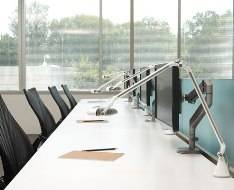August 13, 2013
Worldwide space standards moving closer to UK norm, claims new report
 Worldwide office space standards are now moving closer to the norm seen in the UK according to a new survey from CoreNet Global. According to the CoreNet survey of real estate managers, the average amount of space per office worker globally has dropped to 150 sq. ft (14 sq.m.) , from 225 sq. ft. (21 sq.m.). This is still well outside the standards from the British Council for Offices Specification Guide which reported a fall to 11.8 sq. m. in 2009 and which will be revised downwards even further with the publication of the new guide which has been promised soon. Even this figure might be seen as high and makes assumptions about the relevance of such space standards given the way some firms now work.
Worldwide office space standards are now moving closer to the norm seen in the UK according to a new survey from CoreNet Global. According to the CoreNet survey of real estate managers, the average amount of space per office worker globally has dropped to 150 sq. ft (14 sq.m.) , from 225 sq. ft. (21 sq.m.). This is still well outside the standards from the British Council for Offices Specification Guide which reported a fall to 11.8 sq. m. in 2009 and which will be revised downwards even further with the publication of the new guide which has been promised soon. Even this figure might be seen as high and makes assumptions about the relevance of such space standards given the way some firms now work.



























August 14, 2013
Proceed with caution when using social media to recruit new talent
by Sara Bean • Comment, Knowledge, Legal news, Workplace
Time was, not so long ago that a job seeker could choose which aspects of their experience, interests and personality they wanted to reveal on a job application. For the employer this meant wheedling out the right candidates from a pile of written applications, then using the interview process to determine whether the applicant measured up to their requirements. Today, social media not only makes it easier for employers to reach a much wider universe of candidates – it also gives them the opportunity if they choose, to screen potential employees, and this is where legally, ethically and practically, new largely uncharted problems lie. More →